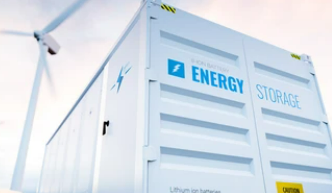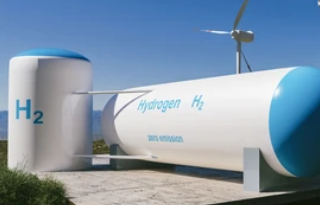
Charlie Brooks
Apr 24, 2022 16:52

Because the impacts of climate change are already being felt in many parts of the world, there is a strong incentive for carbon capture technology to develop.
Carbon capture is removing carbon dioxide from the atmosphere and collecting it before it can be released into the environment. Carbon capture is vital today and in the future because it helps mitigate global warming by reducing carbon emissions in the atmosphere.
Investing in firms that are setting the pace in carbon capture and its growth throughout the globe might be critical to advancing the technology.
Carbon capture and storage is a technique for capturing and storing carbon dioxide. Typically, this is accomplished at the source of the emission. Carbon capture's primary objective is to keep carbon dioxide out of the atmosphere, and this can contribute to the slowing of global warming.
Consider placing a bag over your car's exhaust pipe to visualize carbon capture. This bag would then act as a carbon dioxide trap. When the bag is full, simply discard the emissions. This type of solution would let you continue driving your gas-powered car without having to worry about its environmental impact.
The real process of carbon capture is far more sophisticated than what I have just outlined. Due to the fact that carbon dioxide is a gas, it cannot be captured in a bag; rather than that, it must be chemically separated at the molecular level.

Carbon capture is still a developing technology due to the complexity of the process. However, if it becomes financially viable, there is a strong possibility that it will become widely utilized virtually instantly. It may even eliminate the need for alternate energy sources entirely. Humans may continue to burn fossil fuels, sequester carbon, and have a negligible impact on the atmosphere.
It would assist people in bridging the divide between today's fossil-fuel-powered world and a clean, alternative-energy-powered future.
Carbon capture and storage (CCS) has existed since the 1970s. However, it is still in its infancy. CCS is capable of capturing CO2 from sources such as power plants, refineries, cement, and steel mills. Who can keep carbon dioxide underground once it is caught?
While some criticize CCS for mitigating emissions without removing them entirely, proponents argue that the world will continue to use fossil fuels for some time. Additionally, businesses such as cement manufacturing are exceedingly difficult to decarbonize, and CCS is preferable to doing nothing.
Reduced emissions from damaging activities such as burning fossil fuels may not be sufficient to mitigate climate change. We may need to remove existing carbon dioxide from the atmosphere.
Direct air capture entails the installation of massive fans that extract carbon from the air. Who can use renewable energy to power fans, and who can store carbon underground. Climeworks, the most well-known carbon capture firm, even allows customers to pay for carbon removal in order to offset their own carbon emissions. Although the technology is incredibly expensive and consumes a great deal of energy, it enables us to quantify the amount of carbon removed.
Finally, planting trees is another method of carbon sequestering and storage. While there are numerous attempts to plant trees in order to remove CO2 from the air, tree planting has a number of detractors. They are concerned about a lack of land suitable for planting such a large number of trees, the risk of woods burning down, and the possibility of logging simply shifting from one place to another.
Carbon capture and storage (CCS) is one of the technologies that have the potential to rapidly remove carbon dioxide from the environment. Carbon capture stocks are critical in light of the continued reliance on coal-fired power plants in the energy sector.
With many world governments pursuing carbon-free electricity generation, carbon capture stocks may prove to be extremely rewarding investments in the future.
CCS is the process of capturing the carbon dioxide produced by various industries and reusing it or storing it deep underground. Carbon is typically absorbed from big point sources, such as the combustion of fossil fuels, chemical plants, and other businesses.
When a business employs technology to capture carbon, it is doing more than simply burying it for a rainy day. Captured carbon can be used to improve oil recovery, boost plant growth, and create concrete, chemicals, and fuels. While some of these objectives may seem counterproductive, they are better than nothing. According to experts, what might value CO2 capture technology at up to $1 trillion by 2030?
Large oil and gas firms such as Shell, Chevron, Total, Equinor, and Occidental Petroleum dominate carbon capture and storage. Exxon Mobil currently stores 9 million tons of carbon annually and aims to invest billions in carbon capture and storage projects. Occidental Petroleum intends to offer third parties its carbon capture and storage (CCS) services. However, oil companies benefit from refining oil, not from carbon capture. As a result, oil reserves are not suitable for carbon capture.
However, two publicly traded firms, Aker Carbon Capture and Delta Cleantech sell carbon capture technologies. Additionally, you can invest in voluntary carbon credits through Carbon Streaming Corp. or in carbon credit futures via an exchange-traded fund (ETF) such as KRBN.
Unfortunately, direct air capture is not financially feasible. Climeworks and Carbon Engineering, for example, are not publicly traded on stock exchanges. Rather than that, they are financed by benefactors such as Bill Gates and venture investors.
A carbon capture stock is a company's stock that is engaged in the business of preventing carbon dioxide (CO2) from entering the environment and other climate change activities.
Fortune Business Insights projects that the worldwide carbon capture sector will expand from $1.75 billion in 2019 to $6.3 billion in 2027.
Capturing carbon (CO2) is one of the hottest topics of discussion among environmentalists, especially as more "green" programs are implemented globally.

As a result, investing in carbon capture stocks early on has the potential to provide significant profits for investors. Prior to investing in carbon capture stocks, it is critical to understand the dangers and similarities across individual stocks.
Carbon dioxide reduction is crucial for attaining the Paris Agreement's goals of limiting global temperature rise to far below 2 degrees Celsius this century and promoting efforts toward a 1.5 degree Celsius limit above pre-industrial levels. However, much of the damage has already been done; seasonally adjusted carbon dioxide concentrations in the Earth's atmosphere have increased considerably over the last half-century and continue to grow.
According to KPMG, carbon dioxide has become a significant business liability, reducing a firm's worth by $212,000 for every 1,000 metric tons produced.
And, even as the globe shifts toward renewable energy, carbon will very certainly continue to be burned to supply global energy demands for the foreseeable future. That is why carbon capture and sequestration (CCS) technology has the potential to make a significant contribution.
Carbon capture technology has generated controversy since it supports the use of fossil fuels and may detract from efforts to transition to a 100 percent renewable grid. Nonetheless, demand for fossil fuels may continue to grow for another decade or more (although at a slower rate), and fossil fuels will remain an integral part of the energy ecosystem. As a result, carbon capture has the potential to grow into a multibillion-dollar global business worth up to $1 trillion each year. We anticipate that investors, activists, firm management teams, and policymakers will all become more involved with this technology in the coming years.
Several of the primary risks associated with investing in various carbon capture stocks include the following:
Individual stocks with a high degree of volatility
Regulations by the government
Inadequate liquidity
Inadequate disclosure of the exact availability of physical uranium
Businesses that are unproven
While there are numerous hazards, investors can still profit from carbon capture stocks through share appreciation.
A fascinating facet of the carbon capture sector is how frequently established corporations adopt the technique despite their existing business models being far from carbon neutral.
Occidental Petroleum Corporation of the United States is one of the largest shale gas producers in North America. It is leveraging the revenue generated by those operations to fund the development of a carbon capture division to capture and retire more CO2 than its operations produce.
Oxy Low Carbon Ventures (OLCV), a company established to specialize in the field, is pioneering transformational and sustainable business models that make novel use of human-caused CO2 emissions. Net-zero oil and fuels, net-zero chemicals, and net-zero concrete are among the initiatives.
The large amounts of debt on the balance sheet could be a constraint on R&D spending, but if OXY overcomes that hurdle, the technology it develops will be commercially viable.
As the self-proclaimed industry leader in carbon capture, the company currently owns a number of proprietary technology and solutions.
Its carbon dioxide capture technology is cost-effective, and it also offers options for utilizing captured carbon. One of its companies is only involved in the business of carbon credits.
Despite its small market capitalization, the company has established an amazing global footprint.
The stock, which was launched in August 2021, has largely plummeted since its inception following a brief period of post-inception gain. However, the corporation can thrive if the Canadian government begins enforcing hefty carbon credit prices and penalties.
Equinor, the Norwegian oil company, is one of the world's oldest CCS specialists. It holds shares in more than 30 CCS projects, including the Norwegian government's Northern Lights project, which has a 1.5 million ton carbon dioxide storage capacity per year.
Additionally, it has been rapidly expanding its renewable energy portfolio. It generated 304 GWh of wind energy during the third quarter, which is worth more than $100 million in annual electricity rates.

The oil and gas behemoth has steadily expanded its asset base and brought new ones online during the last decade. Its operating performance metrics remain in the green, with double-digit growth in both the top and bottom lines over the last year. Cash flows for the year to date total an astonishing $16.4 billion.
Additionally, the EQNR stock is only available for one-time forward sales despite its remarkable performance.
Schlumberger Limited (NYSE: SLB) is a diversified technology firm specializing in energy access. Clients include large oil and gas companies. The business has been mapping, measuring, and modeling subsurface rock formations for over 80 years. Additionally, it delivers decarbonization solutions to its customers, capitalizing on the oil and gas industry's critical role in the green energy transition.
Schlumberger has been developing carbon capture projects since 2005 and is currently involved in over 50 CCS programs worldwide. Thus we believe it deserves to be included on this list of carbon capture stocks. Schlumberger developed a new energy business, Schlumberger New Energy, to pursue new growth opportunities in emerging energy industries, including hydrogen, lithium, energy storage, carbon capture and storage, geothermal power, and get energy for heating and cooling buildings.
The business has partnered with LafargeHolcim, Chevron, and Microsoft to develop carbon capture and storage systems. It continues to invest in new energy technology ventures and innovative partnerships in strategic industries, claiming to be diversifying its clean energy portfolio of projects in selected countries and regions with favorable policy environments.
Aker Carbon Capture is one of the few pure-play carbon capture stocks out there. It was Aker Carbon Capture is one of the few remaining pure-play carbon capture stocks. It was spun off from Norway's Aker Group, the world's largest energy company. It is exclusively available in Norway, Denmark, and the United Kingdom. Additionally, it began trading on US markets in 2021.
This carbon capture company provides the following five services:
Just Catch is a cost-effective carbon capture and storage facility.
Reduces emissions from offshore gas turbines with Just Catch Offshore.
Aker's large-scale carbon capture solution, Big Catch.
Carbon Capture as a Service: Complete carbon capture services.
Just Test is a piece of self-contained mobile testing equipment.
Notably, Aker's team believes that simply shifting to alternative energy sources will not be sufficient to meet the Paris Agreement's criteria. In essence, they argue that simply offsetting or reducing carbon emissions is insufficient. Rather than that, they must begin actively removing carbon from the atmosphere. This tailwind is already forming.
Between 2020 and 2021, the worldwide carbon capture and storage capacity more than doubled. This increased the world's total carbon dioxide capture capability to almost 200 million tons per year.
Aker is uniquely positioned in the market as one of the only pure-play carbon capture stocks. It possesses a small number of patents that safeguard its technology from competitors. Additionally, its technology has logged 50,000 operating hours so far. If the company is successful in Europe, there is no doubt that it will rapidly expand internationally.
Carbon Streaming Company employs a novel approach to carbon capture. The corporation invests in global carbon offset projects. The majority of these initiatives involve planting trees, which absorb carbon from the air. Carbon credits are issued to project owners, who can subsequently sell them. While there is some controversy over the effectiveness of tree planting, the voluntary carbon credit market is booming.
Carbon Streaming can sell carbon credits to businesses that have committed to "offset" their emissions in order to achieve net-zero emissions. Numerous businesses have pledged to be carbon neutral by 2030 or 2050, and others, such as Microsoft, have even claimed to be carbon negative.
Carbon Streaming's carbon offset portfolio consists of the following investments:
Rimba Raya is a REDD+-certified project in Borneo, Indonesia, that protects swamp forests. Over the course of its 30-year life, the project should eliminate or cut 130 million tons of CO2 emissions. For more than a decade, Rimba Raya has been generating carbon credits.
In Baja California Sur, Mexico, the MarVivo Blue Carbon Project protects mangroves and marine life.
The Bonobo Peace Forest Project aims to halt forest degradation in the Democratic Republic of Congo.
The Cerrado Biome Project is a Brazilian grassland conservation initiative.
While it takes time for new projects to generate carbon credits, the voluntary carbon credit market has been booming.
While Exxon Mobil is best known as an oil business, it is also a world leader in carbon capture and sequestration.
While environmentalists may be critical of Big Oil, these firms do not want to be left behind as the world transitions away from fossil fuels.
Exxon is frequently a pioneer in new technology due to its financial resources for research and development.
Exxon's disclosure of emission-reduction targets has piqued the interest of environmentally-minded investors, with the XOM stock price rising 47 percent in the last year.
Exxon Mobil has a market capitalization of about $259 billion, making it one of the largest firms in the world. Investors in XOM have received a return of more than 48% over the last year. Passive income investors will adore Exxon Mobil's 4.94 percent yield, which would provide an excellent source of passive income throughout retirement.
FCEL is a global distributor and producer of fuel cells and the provider of the SureSource carbon capture technology. FCEL sequesters carbon and greenhouse gas emissions from existing coal or gas-fired power facilities using its molten carbonate fuel cell technology. FuelCell's technology enables it to achieve a carbon capture rate of 90 percent while incurring only a slight increase in power operating expenses.
FCEL stock has outperformed the broader market this year, rising 20% year to date to $6.28 a share.
FuelCell Energy missed analysts' earnings per share guidance in the last two quarterly reports but exceeded revenue expectations by $5.53 million in the first quarter of 2022. Although the clean-energy stock is not likely to earn a profit in the next two years, net sales are forecast to nearly double to $137 million this year from $69.6 million in 2021.
Despite its unprofitability, with exposure to CCUS technology, this firm had a net cash position of $343 million at the end of 2021 and is forecast to lower its free cash flow loss to $160 million in 2022, down from a whopping $768 million deficit last year.
The company trades at a premium to its forward EV/Revenue ratio of 15.4x and a 2022e P/B ratio of 4.32x. FCEL, on the other hand, is one of the main businesses with exposure to the complex due to growing investor interest in carbon capture technologies.
As the world progresses toward a more environmentally friendly future, it is feasible that many of these companies may be listed on multiple stock exchanges. The carbon capture sector is benefiting from an inflow of investment and net-zero commitments from governments and enterprises, which has increased the market's stock of carbon capture equipment. The current study's findings reveal that the industry has numerous opportunities for growth and market expansion.

Apr 24, 2022 16:37

Apr 24, 2022 17:05